Hiring used to be a lot simpler. You put out a job ad, got a decent batch of applicants, picked the best one, and boom — you had a new employee. Those were the good old days. Now? It’s a different story.
If you’ve tried to hire recently, you know the struggle. Candidates don’t show up for interviews. The ones that do often expect a management salary for an entry-level job. Finding good employees feels like trying to win the lottery, and in some areas, especially rural towns, the talent pool is more like a talent puddle. Business owners everywhere ask the same question:
Where did all the good workers go?
The truth is that the workforce has changed. People want different things from jobs now — more flexibility, better pay, and less stress. Some don’t want to work at all. Employers are left scratching their heads, wondering how to attract reliable, hardworking employees who won’t disappear after a week.
But here’s the thing: Hiring isn’t hopeless. You just have to change your approach to it. You’ll struggle if you’re still doing things as you did 10 years ago. But suppose you’re willing to rethink your hiring strategy, get creative, and make a few adjustments. In that case, you can find great employees, even in this job market.
This article isn’t a list of boring HR theories or corporate jargon. It’s about real, actionable strategies that work. Sound good? Great. Let’s roll up our sleeves and get to work.
The vanishing interviewee phenomenon

You schedule an interview, block off time, and then — nada. No call, no email, just a disappearing act. If this sounds familiar, you’re not alone. Ghosting has become a standard move for job seekers who apply for dozens of jobs at once, take the first offer, and ignore the rest.
So, how do you stop wasting time on no-shows? Text reminders work better than emails, as a simple “Looking forward to seeing you tomorrow at 10 a.m.” increases attendance.
Pre-screening with a short video call or recorded response also helps weed out the tire-kickers. Instead of immediately booking an in-person interview, ask candidates to hop on a quick five-minute video chat first. This casual check-in makes it easier to gauge interest, and candidates who aren’t serious won’t bother.
Another option? If you don’t want to book a five-minute call, ask applicants to submit a short, recorded video answering two or three questions (like “What interests you about this job?”). If they can’t put in that effort, they’re unlikely to show up for an interview anyway.
The ‘I want to start as a manager’ dilemma
Many job seekers today aren’t looking for a job; they’re looking for a shortcut. They apply for entry-level positions but expect management titles, top-tier salaries, and a corner office by next Tuesday. Some assume a college degree should automatically land them a leadership role, while others entirely skip over the “working your way up” part.
So, why has entry-level lost its appeal? Remote jobs, side hustles, and gig work have changed people’s thoughts about traditional career paths. The idea of “starting at the bottom” isn’t as popular anymore.
The fix? Set clear expectations from day one. In job postings, outline the career growth path, including timelines for raises and promotions. During interviews, be upfront: “We promote from within, but we need to see solid performance first.” If a candidate expects to be a manager immediately, ask them, “How would you train someone on a job you’ve never done?” This will reset expectations quickly.
Another tactic? Reframe job titles. “Production assistant” sounds like a dead-end job; “production apprentice” suggests growth. A minor tweak in language can make an entry-level role feel like the start of something bigger with a future.
The goal isn’t to suppress ambition; it’s to redirect it into action. Show new hires the path forward, but clarify that getting to the top still requires work.
The small hiring pool problem
Hiring is tough everywhere, but it can feel impossible if you’re in a small town or working in a niche industry like decorated apparel. When the local talent pool is already limited, your hiring choices can feel like picking between “bad” and “worse.” If you’re lucky, you might find someone who’s worked in manufacturing or production before — but good luck finding a candidate who already knows how to separate T-shirt artwork or run an automatic screen-printing press.
The reality is nobody is born knowing how to do this stuff. Screen printing, embroidery, and heat pressing are all specialized work requiring hands-on training. That means expecting to find a fully skilled applicant in the first few resumes isn’t realistic.
The best strategy? Hire for attitude, train for skill. You’ve heard that before, right? It’s still true.
Look for people with transferable skills. Restaurant workers who can handle fast-paced environments, mechanics who understand machinery, and artists who can be taught prepress work. If someone is reliable, teachable, and has a good work ethic, you can train them on the rest.
If your usual hiring methods aren’t working, expand your search. Partner with local high schools, trade programs, veteran training centers, and workforce development offices. Consider hiring part-time workers who need flexibility, like parents looking for a job during school hours or college students who want hands-on experience.
Another often overlooked resource is disability employment programs. Many organizations offer job coaching and financial incentives for hiring neurodiverse or disabled workers. They can also connect you with highly motivated candidates eager for stable employment. These candidates don’t want a handout or charity; they only want an opportunity. More on that later in the article.
At the end of the day, the goal isn’t to find the “perfect” candidate. It’s to find the right person and give them the tools to succeed. When you focus on training and long-term growth, you build a team of skilled employees who stay, learn, and add real value to your business.
Fear factor: Employers’ biggest concerns
Hiring can feel like a gamble. What if you train someone, and they quit a week later? What if they’re not as good as they seemed? These fears are real. But remember, F.E.A.R. is an acronym for false evidence appearing real.
Yes, some hires won’t work out. But what if you find a great one? The best way to overcome hiring anxiety is to control what you can. Refine your hiring process, set clear expectations, and focus on retention.
Are you worried about turnover? Give people a reason to stay. A solid onboarding process, clear growth paths, and a positive work environment go a long way. If you’re concerned about pay competition, focus on what makes your workplace better. A supportive team, flexibility, and low stress can be just as valuable as a bigger paycheck.
And here’s something to consider: Every day, your employees go home, and someone asks, “Hey honey, how was your day?” You are in control of their response. If they’re frustrated and dreading tomorrow, they won’t stay. But if they feel valued and enjoy their work, they will. And maybe they’ll bring others with them.
Instead of fearing the hiring process, use it as a chance to build a high-performing team. Employees who see that effort leads to opportunities such as raises, promotions, and new skills stay engaged. A workplace where results matter, hard work is rewarded, and people take pride in their work isn’t just a job. It’s a culture.
And when you build that kind of culture, hiring stops being a headache and becomes your biggest advantage.
Rethink the hiring process
Hiring in the decorated apparel industry should not feel like a corporate HR exercise. We are not hiring brain surgeons. We print T-shirts, and let’s be real; it is pretty fun. If your hiring process is as dry as a job at the DMV, you are doing it wrong.
Speed matters. First, ditch the lifeless job ad. No one wants to apply if your posting sounds like a robot wrote it. Instead of “Looking for a detail-oriented individual to perform garment decoration duties in a fast-paced environment,” try something like, “Tired of boring jobs? Work with a team that actually likes each other. We print T-shirts, crack jokes, and help awesome customers bring their ideas to life. If you enjoy making cool stuff and working with people who don’t suck, apply today!”
Even better, record a quick video showing your shop in action. Have your best employee say, “I started here three years ago and still love it. Plus, my closet is 80% free T-shirts.” That will do more to attract good candidates than listing “competitive pay” for the thousandth time.
And here’s an easy win: Get your current employees to recruit for you. Ask them to share job openings on social media or tag friends who might be a good fit. Offer a referral bonus if their hire sticks around, payable at the new employee’s 90-day mark. People trust their friends, and if your team brags about how much they like working there, it is way more convincing than a job ad that looks like every other one out there.
The goal is simple. Make applying easy. Show that your shop is a great place to work. Move fast when you find the right person. We are in the T-shirt business, not an accounting firm. Make hiring as fun as the work itself, and you will attract those who want to be part of it.
Turn social media into a hiring tool

Most people spend more time on social media than looking for jobs. That is why platforms like LinkedIn, Instagram, and Facebook can be great recruiting tools.
Use LinkedIn for professional roles like sales reps, managerial staff, or designers. If you need someone hands-on, Instagram and Facebook are better.
Also, get into local Facebook groups. A quick post like, “Know someone who loves T-shirts and working with their hands? We are hiring!” and ask people to share the post. People trust recommendations from people they know; the best hires often come through word of mouth.
Host hiring events & trial days
Do you want to find out if someone is the right fit before hiring them? Give them a chance to experience the job first.
Home Depot has weekend events where parents bring their kids to build a birdhouse or a toolbox. Although this is a free community event, it is actually a clever recruiting tool. Suppose a parent appears handy and comfortable with tools. In that case, an employee will pull them aside and ask if they have ever considered working there. You can do the same thing.
Host a “Print Your Own Shirt Day” where people can come in, learn the basics of screen printing, and take home a custom T-shirt they made themselves. It is a fun event for the community and a great way to spot potential employees. If someone picks up the process quickly, asks thoughtful questions, and seems genuinely interested, they might just be your next great hire.
Partner with schools & local programs

Some of the best employees you will ever hire do not even know this industry exists. Many schools focus on pushing students toward college or trade careers like plumbing and welding. Very few mention that making T-shirts, running embroidery machines, or designing graphics can be a full-time job.
Partner with high schools, trade schools, and community colleges to offer apprenticeships or internships. Give students a chance to get hands-on experience and see if they like the work. If they do, you now have a trained future employee.
Do not overlook vocational programs and workforce development centers. These organizations train people eager to work but need a starting point. Many also help cover training costs, making it a win-win for both you and the employee.
Hiring neurodiverse & disabled workers

Many businesses are missing out on a workforce of skilled, motivated people simply because they are not looking in the right places.
Neurodiverse and disabled individuals are among the most underemployed in the country, not because they lack ability but because traditional hiring practices create unnecessary barriers.
These people thrive on structure, focus on details, and bring problem-solving skills that can elevate your business. They can perform every job you have in the building. This is not just a hiring strategy. It is an opportunity to bring in people who will show up, work hard, and stay.
If you struggle to find reliable employees, this is your solution, usually right under your nose. Reach out to job coaching programs, vocational rehab centers, and disability employment services. These organizations do more than connect you with great candidates. They also provide training, support, and even financial incentives to help make hiring easier. The best part? These employees want to work. They are not just looking for a paycheck; they are looking for a place where their skills matter.
Hiring is just the beginning. Success happens when employees feel supported. Many neurodiverse workers thrive with structured workflows, written instructions, and step-by-step training guides. If your current training plan is “watch and figure it out,” it is time for an upgrade. Accommodations do not have to be expensive or complicated. Sometimes, it is as simple as offering noise-canceling headphones, adjusting a workspace, or providing a clear checklist.
When you create an environment where everyone feels valued for what they bring to the table, you are not just filling jobs. You are building a team that is stronger, more engaged, and invested in the company’s success.
The future of hiring (& why it’s not hopeless)
If you want different results, you have to try something new. The right employees are out there, but finding them means looking beyond job boards, moving fast, and creating a workplace that people want to work in. The best hiring strategy is finding the right people and creating a place where they want to stay. The question is simple: What are you willing to do differently to solve your problem?




